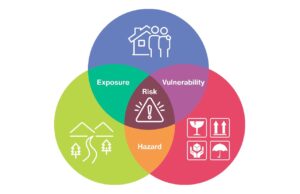
Broadening the scope of urban flood risk assessment
By DAVID SOL
Construction Infrastructure Risk ManagementIncorporating long-term adaptation and resiliency strategies along with structural mediation into flood risk models.
According to a recent federal task force report, flooding — particularly in urban areas — accounts for the largest portion of disaster recovery costs annually in Canada. Hence, the urgently growing awareness among government and private sector players in the building sector to reduce flood risk as a key to developing and supporting resilient and prosperous communities across the country.
The major challenge is that flood mitigation planning and modelling, which is used to better understand the impact, relative risk, and potential for flood risk reduction, is complex and we lack data on many vulnerabilities.
No question, major floods can have a wide-ranging impact, including direct property damage, indirect supply chain issues, diverted resources, and intangible mental health strains and contamination releases. And while life safety and well-being are rightfully the top priority for municipal engineers, planners and officials charged with devising solutions to the flooding problem, the financial cost of flood damage to Canadians is a major and growing impediment to our prosperity.
FLOOD MITIGATION
Nearly 70 years ago, American geographer Gilbert White, known as the father of flood plain management, wrote, “Floods are ‘acts of God,’ but flood losses are largely acts of man.”
A pioneer in adopting an approach to flood mitigation that considered the influence of human behaviour, White cautioned against being overly confident on structural mitigation solutions and insufficient building design standards to reduce the damaging impact of floods. His concern then, which has proven to be extraordinarily prescient, was that people would let down their guard and assume that all would be well even after an unanticipated flood did occur.
In the years since, we have continued to rely on prevention strategies and, in many cases, increased our exposure to potential flood hazards. However, the costs of flooding and climate change are making it clear that an adaptive approach is necessary to increase our resilience and recovery from flooding.
In other words, because natural floods can’t be prevented, addressing urban flood exposure through such mechanisms as land use regulations, for example, or by addressing vulnerabilities by way of everything from building standards to permitted uses, cultural awareness and disaster preparedness, is more in keeping with an adaptive approach to urban flood damage prevention.
Of course, structural approaches are easier to assess through standard cost-benefit analyses. Non-structural options, on the other hand, occur over time and in complex ways, making it much harder to account for the costs and benefits of such alternatives in a dynamic social and built environment,
Fortunately, our ability to assess non-structural alternatives with risk modelling has improved and we can model alternative exposure and vulnerability options to assess these benefits.
WHAT IS RISK?
Risk is a broadly used term but has a specific meaning in the context of urban flood mitigation. Consider a typical building within the floodplain of a nearby river. Water that floods a metre deep on the main floor would cause significant property damages — one of the many consequences of that single flood event. In the meantime, a different flood event at that same location may only lead to some minor basement flooding, with less damage and ensuing repair cost.
While the likelihood of a flood occurring and the consequences that follow are hugely variable, viewed together, a measurable risk value begins to emerge.
Risk includes the probability of a consequence being experienced. Consequences for an asset, such as a building, can further be understood as the product of the exposure to a flood hazard and the vulnerability of that asset to the hazard in question.
For example, a home with an empty undeveloped basement has different vulnerability than if the basement was developed with bedrooms, a home theatre, art collections, storage of family documents and keepsakes, etc. Vulnerability is not only value, however, and the fully developed basement could have less vulnerability if it was thoroughly floodproofed to prevent the entry of any water.
Therefore, risk can be illustrated as the cumulative interaction of hazard, exposure, and vulnerability, as in Figure 1.

Figure 1: Illustration of risk as an interaction of hazard, exposure, and vulnerability. (Source: Arcadis IBI Group)
This simplified illustration of risk is useful to illustrate that all three elements are needed to complete a proper risk assessment.
Flooding alone is not a risk. In fact, many landscapes have evolved to be dependent on regular flooding. Likewise, without exposure or vulnerability, there is no risk. Adding probability to the hazard allows us to quantify the risk, which can help us understand if minor basement flooding every year or the potential for a rare but severe flood is of most concern for the metrics measured.
If we are only measuring repair costs, we may find that small but frequent flooding represents greater financial risk than a devastating but rare event. However, if we are only concerned about life safety risk, we may find the opposite.
RISK MODELLING
Risk as a product of hazard, exposure, and vulnerability is also useful for understanding the inputs for risk modelling. Estimating flood exposure, consequences, and risk requires spatial analysis to determine exposure and object-based estimates involving a significant number of calculations. The development of software tools has made risk modelling more accessible and efficient.
To this end, IBI Group’s flood risk and mitigation planning team has worked closely with Natural Resources Canada (NRCan) to develop Canada’s first flood risk modelling toolkit, CanFlood.
An open-source QGIS plugin, CanFlood was first released in the spring of 2021 and the development of new features continues. The plugin is available directly within the QGIS repository or as a download on GitHub. Documentation and tutorials are also available on the GitHub site.
With CanFlood, we now have a standardized toolset for flood risk assessments. However, the greatest model is only as good as the data it is fed. Even the most tangible of flood impacts — building damages — requires new data on the vulnerability of the structure to flooding.
To achieve this, NRCan is working with IBI Group to provide a Canadian framework and vulnerability function library for flood risk assessments and is engaging directly with a range of industries, including design, construction, and restoration specialists to provide data input.
If you have experienced flood losses or have identified any vulnerabilities or adaptations in your work and would like to contribute data to the project, I encourage you to get in touch with us at http://ibiengage.com/floodrisk/. We will be collecting data at least until the end of this year.
LIFECYCLE CONSIDERATIONS
Risk assessments may be used to provide an indication of the protection, or benefits, provided by flood control structures. However, mitigation planning should consider the lifecycle of the structure and the community, including the additional hazard of structures failing, future increases in exposure from continued development, and the resulting consequences.
Rather than simply assessing how to protect what we have built today from a dynamic and uncertain future hazard, we should also consider how dynamic our communities are and how we can adapt to the hazard and increase our resilience.
To do so, we need to adopt a longer-term outlook and we all need to work together and incorporate risk through the policy, planning, design, and construction phases of our communities’ redevelopment processes.
The tools are there to make it happen. With engagement, you can help us better our understanding of flood vulnerabilities and the impacts on your work.
David Sol is an associate and manager of planning at Arcadis IBI Group where he leads a multidisciplinary team to complete flood risk assessments and mitigation planning all across Canada.





